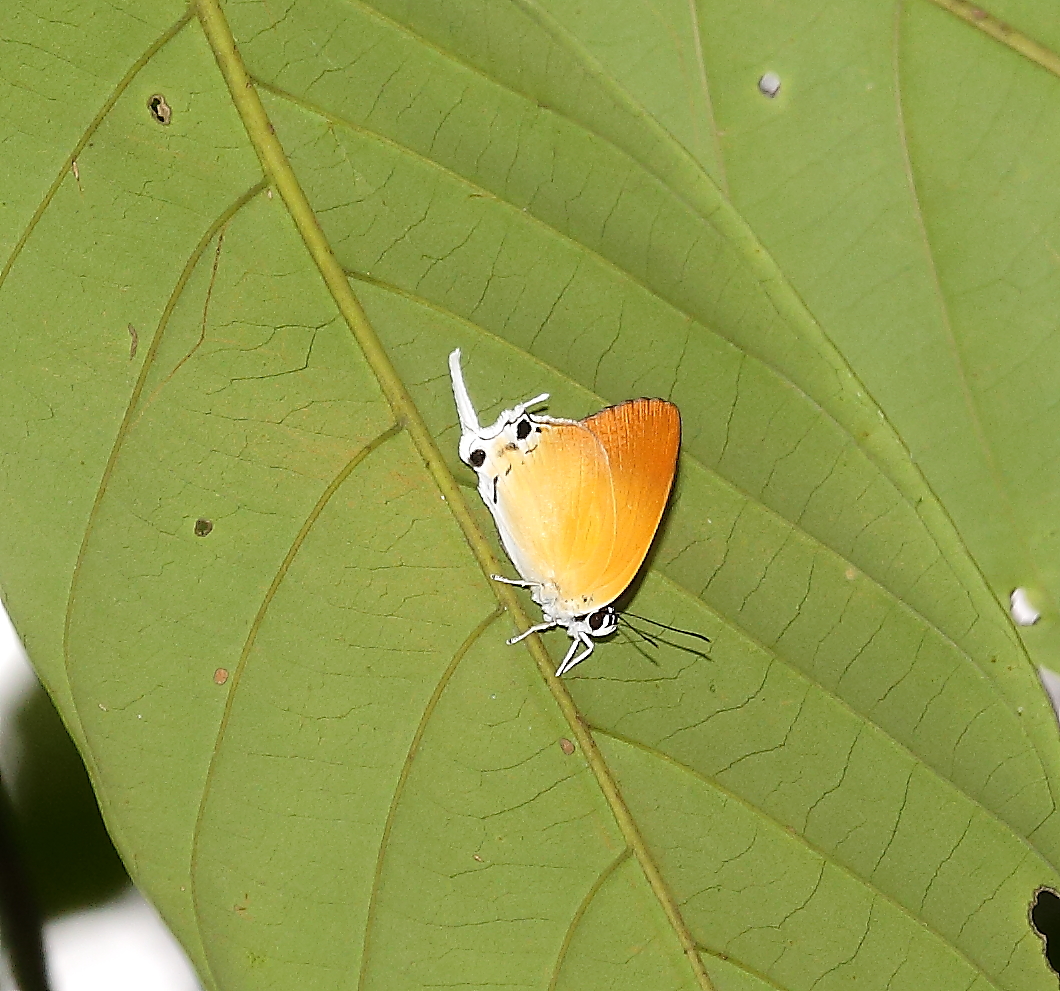Dear Dr Seow, please help with the following IDs, thanks!
(1) Rapala?
(2) Green Imperial (Manto hypoleuca terana)

Dear Dr Seow, please help with the following IDs, thanks!
(1) Rapala?
(2) Green Imperial (Manto hypoleuca terana)

Cher Hern
The Rapala is R. varuna- the post-discals are broader than in manea and scintilla
Aaron Soh
I think it is more likely to be a female Rapala scintilla.
R. scintilla & varuna are very similar. Bands are relatively broad & on the HW the postdiscal band & cellend bar are very close.
The underside of R. scintilla is grey brown with a greenish tinge.
The part of the band in space 1b (beside the grey-green patch) is usually somewhat straight as in manea but may varies. Note on L side it is straight, & on R side it forms an arch.
The flattened black spot is not an ID mark as it varies.
R. varuna female ; Underside is strongly purple washed.
http://2.bp.blogspot.com/-ZmTmOJhE83...ndigoFlash.jpg
R. scintilla females.
Malaya.
https://www.thaibutterflies.com/wp-c...a-1080x675.jpg
Thailand.
http://www.phuketnaturetours.com/Pag...0%20-%20Phuket
Borneo.
https://upload.wikimedia.org/wikiped...72_473_AC1.jpg
Others.
Rapala rhodopsis.Un copper brown ;band narrow/one side white edged; black spot may be flattened.
https://4.bp.blogspot.com/-UI_BkKM6Y...016%2B17mm.JPG
Rapala hades. Un brown ;HW band & cellend bar far apart; black spot may be flattened.
https://species.wikimedia.org/wiki/R...eville1895.JPG
I suspect this species in the past with one of Federick's shot Toa Payoh, 2004.
The dark blue-marked upperside often suggest R. manea.
http://photobucket.com/gallery/user/...LmpwZw==/?ref=
2. Manto hypoleuca.
The V mark in M. hypoleuca is very close to the adjacent black streaks on both side.
In Mantoides gama it is well separated.
M. gama.
https://www.thaibutterflies.com/wp-c...oides-gama.jpg
http://v3.boldsystems.org/pics/KHCBT...1323323946.JPG
http://i57.tinypic.com/osa5nr.jpg
TL Seow: Cheers,
PS. Females of R. manea & one male Singapore for comparison.
THe HW band & cellend bar are well separated.
http://2.bp.blogspot.com/-enC5GgBMeV...ash-ChngCK.jpg
http://www.butterflycircle.com/check...20-%20Khew.jpg
http://www.butterflycircle.com/check...James-chia.jpg
http://4.bp.blogspot.com/-q3cFJczGJn...ba)+female.jpg
http://farm6.staticflickr.com/5454/8...9562574d_c.jpg
Male
http://3.bp.blogspot.com/--_OcJrIvZG...ea_chozeba.png
A puzzling male. This has the appearance of R. scintilla male.
http://www.butterflycircle.com/check...0Ben%20Jin.jpg
Last edited by Psyche; 12-Jun-2018 at 10:40 PM. Reason: PS
Quite rightly so.
However some variation always occur.
The other factors are R. varuna is rather dark on the underside, & the HW band & cellend bar are so close they usually touch.
http://nlliew66butterflies.blogspot....na-orseis.html
The Bornean book on Lycaenids also give a good match, Page 67/74, L355.
http://www004.upp.so-net.ne.jp/jamid.../borneo-e.html
It also give a good match to this male labelled as R. dieneces in the past.
The FW band has a distinct bent, & the ground colour is olive brown which has a hint of green.
This just would not match any of the known males in Singapore.
http://www.butterflycircle.com/check...0Ben%20Jin.jpg
TL Seow: Cheers.
PS. There are examples of R. varuna from other areas in which the underside is pale eg. India ( HW band & cellend bar touching)..
The ID of R. scintilla may be a bit premature without further observations.
You could still be right . It may turn to be a form of R. varuna.
Last edited by Psyche; 13-Jun-2018 at 08:06 PM. Reason: PS
Maybe an unusually pale female? Too bad we don't know the extent of variation of these spp.
Aaron Soh